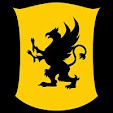
Timber by timber, we raise our lethal engine. Lever arm, angles and angular momentum, its deadly lattice looms over our protective wall. Sounds of the felling, skinning and sawing of logs rise before the dawn, falling only with the failing light of dusk.
In this framework of fact, growth rings of research build one upon another in alternating eras of inspiration and understanding. Care is taken to select only properly aged and seasoned wood. Too green and the beams will twist beneath the counterweight. Too dry, they split and shatter with the backlash of each shot. Sinew binds each joint with the strength of totem spirits.
The pivot pole is capped in the cold-forged iron of experience, the socket greased with empathy without which the machine would wrench itself apart. From the throwing arm, ropes of hemp mixed with virgin lamb's wool dangle. Warrior women weave a sling from the fire-threads of hair our hero cut away to impart a final whiplash to each departing round.
Our mage-general, at once both engineer and architect, oversees construction as well as the insertion of a secret sally port behind a salient in the wall, a new postern through which we will raid and burn the enemy engines, sowing a dense dose of Greek fire through their camp each fortnight, alternating between the darkness and light of new and full moons. Apprentice alchemists weigh every shot for range and volatility as they tamp each clay vessel then stamp their seal in its protective wax. Too precious to waste on ranging, we rely on the targeting sticks set at intervals beyond the wall. In the upcoming battle, we anticipate only minor adjustments before we volley for effect.
Stone by stone we fill the counterweight box with information. We glean castoff blood tests from the rubble of interior walls, quarrying larger scans from the granite of the castle rock. Night and morning, by moonlight and by sun, we haul the jagged rocks. The sledges are heavy, the load can be exhausting. Backs bent, muscles aching, we stumble but continue, rest the domain of the wicked and the dead.
Soon, we strain upon the ropes, drawing them down inch by inch until we capture the moment with a single hook and pin. Taut and creaking, it settles, a coiled serpent readying its venom for a strike.
Tense with trepidation, we await the command to loose, fearful of the price of victory once the siege begins.
© 2007 Edward P. Morgan III

--------------------------------
ReplyDeleteNotes and asides:
--------------------------------
Once I began thinking of chemo as a siege, the actual treatment, the needle itself naturally became a trebuchet. The trebuchet was one of the most feared of the medieval siege engines, primarily because of its range and accuracy. They weren’t and still aren’t easy to build. Hurling 300+ pound rocks almost a quarter mile puts a lot of stress on simple construction materials like morticed and tenoned timber. If they aren’t built right, they tend to fly apart spectacularly. If you’ve even watched the TV show Junkyard Wars, you know exactly what I mean.
One of the most feared ammunitions for any siege engine was Greek fire, an incendiary chemical mixture used by the Byzantine Greeks to set fire to opposing ships. From all accounts, it was like primitive napalm, though the exact formula for it has been lost. In naval warfare, fire is the single most feared weapon. In siege, it is second only to disease.
Picture notes: Given how hard it was to find a trebuchet, even a toy, Karen created a drawing based on a picture of one near Urquhart Castle in Scotland, and set it against a parchment she created.
ReplyDelete